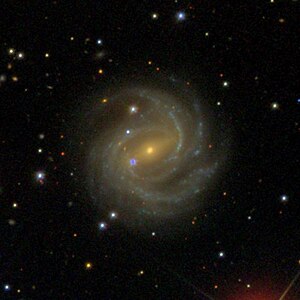NGC 2642
| Galaxy NGC 2642 |
|
|---|---|

|
|
| SDSS recording | |
| AladinLite | |
| Constellation | Water snake |
|
Position equinox : J2000.0 , epoch : J2000.0 |
|
| Right ascension | 08 h 40 m 44.4 s |
| declination | -04 ° 07 ′ 18 ″ |
| Appearance | |
| Morphological type | SB (r) bc / HII |
| Brightness (visual) | 12.6 mag |
| Brightness (B-band) | 13.4 mag |
| Angular expansion | 2 ′ × 1.8 ′ |
| Position angle | 90 ° |
| Surface brightness | 13.8 mag / arcmin² |
| Physical data | |
| Affiliation | isolated |
| Redshift | 0.014494 ± 0.000028 |
| Radial velocity | 4345 ± 8 km / s |
|
Stroke distance v rad / H 0 |
(187 ± 13) x 10 6 ly (57.2 ± 4.0) Mpc |
| history | |
| discovery | John Herschel |
| Discovery date | February 19, 1830 |
| Catalog names | |
| NGC 2642 • PGC 24395 • MCG -01-22-033 • IRAS 08382-0356 • 2MASX J08404435-0407182 • HIPASS J0840-04 • LDCE 584 NED004 • 2MIG 1172 | |
NGC 2642 is a bar-spiral galaxy with extensive star formation areas of the Hubble type SBbc in the constellation Hydra south of the ecliptic . It is estimated to be 187 million light years from the Milky Way and about 115,000 light years in diameter.
The supernovae SN 2002fj (Type-IIn) and SN 2008bh (Type-II) were observed here.
The object was discovered by John Herschel on February 19, 1830 .
